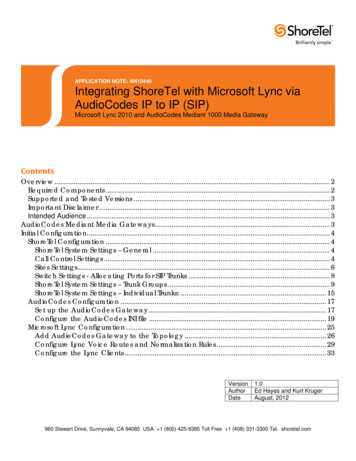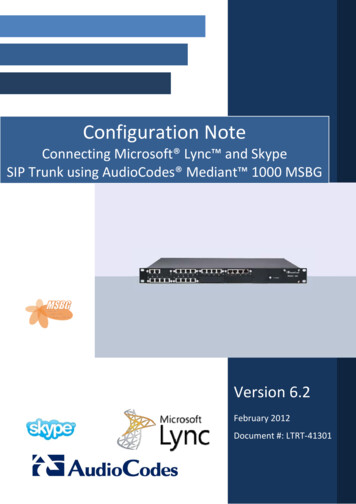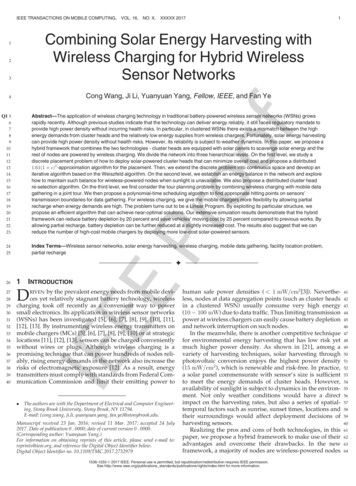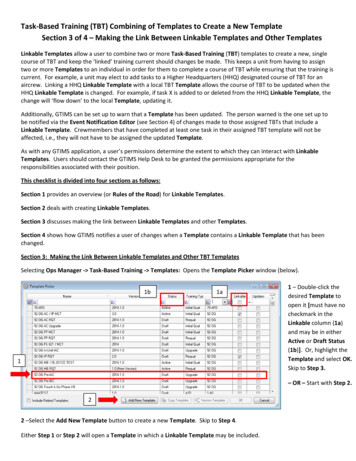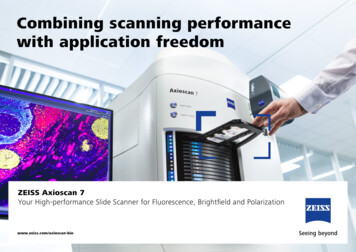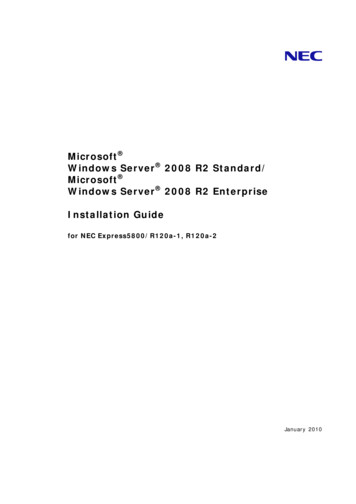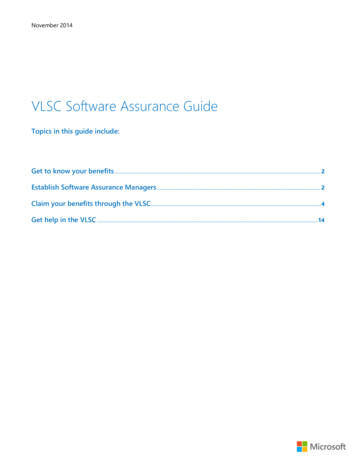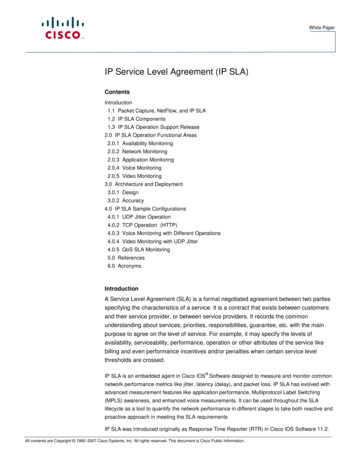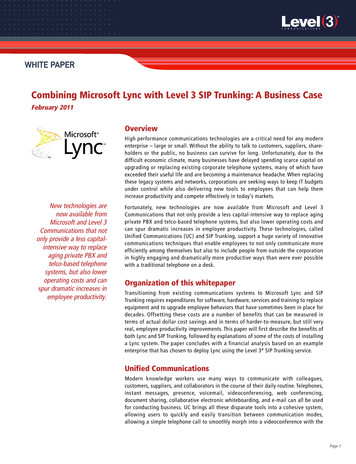
Transcription
WHITE PAPERCombining Microsoft Lync with Level 3 SIP Trunking: A Business CaseFebruary 2011OverviewHigh performance communications technologies are a critical need for any modernenterprise – large or small. Without the ability to talk to customers, suppliers, shareholders or the public, no business can survive for long. Unfortunately, due to thedifficult economic climate, many businesses have delayed spending scarce capital onupgrading or replacing existing corporate telephone systems, many of which haveexceeded their useful life and are becoming a maintenance headache. When replacingthese legacy systems and networks, corporations are seeking ways to keep IT budgetsunder control while also delivering new tools to employees that can help themincrease productivity and compete effectively in today’s markets.New technologies arenow available fromMicrosoft and Level 3Communications that notonly provide a less capitalintensive way to replaceaging private PBX andtelco-based telephonesystems, but also loweroperating costs and canspur dramatic increases inemployee productivity.Fortunately, new technologies are now available from Microsoft and Level 3Communications that not only provide a less capital-intensive way to replace agingprivate PBX and telco-based telephone systems, but also lower operating costs andcan spur dramatic increases in employee productivity. These technologies, calledUnified Communications (UC) and SIP Trunking, support a huge variety of innovativecommunications techniques that enable employees to not only communicate moreefficiently among themselves but also to include people from outside the corporationin highly engaging and dramatically more productive ways than were ever possiblewith a traditional telephone on a desk.Organization of this whitepaperTransitioning from existing communications systems to Microsoft Lync and SIPTrunking requires expenditures for software, hardware, services and training to replaceequipment and to upgrade employee behaviors that have sometimes been in place fordecades. Offsetting these costs are a number of benefits that can be measured interms of actual dollar cost savings and in terms of harder-to-measure, but still veryreal, employee productivity improvements. This paper will first describe the benefits ofboth Lync and SIP Trunking, followed by explanations of some of the costs of installinga Lync system. The paper concludes with a financial analysis based on an exampleenterprise that has chosen to deploy Lync using the Level 3 SIP Trunking service.Unified CommunicationsModern knowledge workers use many ways to communicate with colleagues,customers, suppliers, and collaborators in the course of their daily routine. Telephones,instant messages, presence, voicemail, videoconferencing, web conferencing,document sharing, collaborative electronic whiteboarding, and e-mail can all be usedfor conducting business. UC brings all these disparate tools into a cohesive system,allowing users to quickly and easily transition between communication modes,allowing a simple telephone call to smoothly morph into a videoconference with thePage 1
WWW.LEVEL3.COMFigure 1: Combined Architecture Diagramability to add new parties and share documents and whiteboards whenadditional expertise is required. By unifying communications, corporations canrealize measurable productivity gains and streamline the flow of informationthroughout the enterprise.MICROSOFT LYNCMicrosoft Lync is an advanced UC system that seamlessly combines a widerange of new calling features and capabilities into a single platform that can beaccessed from a variety of devices. By equipping users with voice, video anddata communications tools that have been combined into a comprehensive,unified system, enterprises can help ensure that employees have a wide varietyof modern communication tools at their disposal from a single user applicationwith a consistent interface across multiple platforms.LEVEL 3 SIP TRUNKINGWhen used in conjunctionwith Lync, the Level 3 SIPTrunking service allowsseamless transitions betweenvoice and other types ofcommunication and permitsdramatically simpler networkarchitectures to enable morerobust disaster recoverysolutions and reduce costs.Page 2SIP Trunking is one of the primary enabling technologies for Lync, providing acentralized connection to the public telephone network that can be used tobring voice into Microsoft’s UC system. When used in conjunction with Lync, theLevel 3 SIP Trunking service allows seamless transitions between voice andother types of communication and permits dramatically simpler network architectures to enable more robust disaster recovery solutions and reduce costs. Incontrast, tying together ISDN PRIs from multiple locations into a consolidatedLync architecture, while possible, is overly complicated, expensive and difficultto manage.EXAMPLE OF UCDuring the preparation of this paper, a conference call was held between agroup of Lync users and an outside party. To set up the call, one Lync user sentout an invitation that included the time and date of the call and list of participants. The external party received an automatically generated message thatincluded a telephone number to access a voice bridge using a toll-free numberalong with a passcode that was unique to the planned meeting. (Unbeknownstto both parties, the dial-in number was provided by using the Level 3 SIPTrunking service.) The external party also received a link to a website thatallowed a download of a desktop client program for the user’s PC in order to
support full Lync functionality, including video calling, document sharing andwhiteboarding. During the conversation, additional expertise was needed, sothe Lync user searched the corporate directory for an expert with the right skills.Before the expert was added to the discussion, active presence was used toverify that the expert was available, even though the expert was connected tothe Lync system over an Internet connection from a home office, which wasnecessitated by a snow day in the local school district. As different partiesjoined and left the call, audio levels were automatically adjusted to ensure thatthe participants could hear each other comfortably. When the call ended, eachuser had a copy of the whiteboard diagram available for their use.Benefits of Combining Lync with SIP TrunkingCONVERGENCE AND ACCESSThe purpose of SIP Trunking is to replace the public telephone network connections provided by traditional PBXs with a solution that is more efficient andeasier to integrate. It provides the same basic functions as a PRI (Primary RateInterface) trunk on an ISDN system or a T-1 trunk on a traditional digitaltelephone system, which is to supply a path for both communication (such asvoice calls) and signaling (i.e. the dialing instructions and callsupervision/control) between a customer’s equipment and a carrier’s equipment.SIP Trunking works by converging voice and data access onto a single network,thereby reducing the cost of maintaining duplicate backbones for communications.POOLING CONCURRENT CALL PATHSCarrier contracts for SIP Trunking will normally specify a maximum number ofConcurrent Call Paths (CCPs) that will be supported. One CCP is occupied duringeach active SIP call that is routed through the carrier and then released backinto the pool of available CCPs when the call ends. The total number of CCPsindicates the total number of simultaneous calls that can be transmitted overthe SIP trunk.SIP Trunking works byconverging voice and dataaccess onto a single network,thereby reducing the cost ofmaintaining duplicatebackbones for communications.When multiple sites are connected with SIP telephony over a corporate WAN,the CCPs from all the sites can be pooled into a single SIP Trunking connectionto the carrier. This standard feature from Level 3 (which is an optional extra froma few other carriers and not available from most others) is particularly beneficialfor smaller company sites. Instead of requiring a 24 voice-channel T-1 or a 23voice-channel ISDN PRI telephone company connection to a remote office thatmay have only a dozen employees (and therefore a need to support perhapsthree to seven concurrent calls), these callers can be grouped together with allof an enterprise’s other sites, and share a common pool of CCPs. The benefitsare similar to the practice of centralizing and aggregating Internet trunks in adata center rather than buying direct Internet access into each branch.INTEROFFICE CALLINGCost savings can also be generated by routing calls among different locations ofan enterprise using SIP telephony over the corporate WAN. The Lync server canautomatically recognize and route calls to destinations that are within theenterprise. Plus, unlike services from many other carriers, SIP Trunking servicesPage 3
WWW.LEVEL3.COMfrom Level 3 offer free calling among enterprise locations, even when the callsare routed over the Level 3 Network instead of through the enterprise WAN.TELECONFERENCINGCarriers and third parties offer commercial-grade teleconferencing services forwhat seem like small per-minute fees. However, given the number of hours thatemployees typically spend on conference calls each month, these costs canaccumulate over time and become a major expense item. With Lync, theseexpenses are eliminated, because the servers that form the core of a Lyncsystem installation provide the voice bridging functions that are required forconference calling. These services can also be expanded beyond the boundariesof the enterprise to enable external customers and collaborators to easily participate in a teleconference.WEB CONFERENCINGAs in the market for teleconferencing, a number of service providers andtechnology suppliers have emerged over the past decade to supply web conferencing services that allow employees to deliver rich-media presentations,including video, application sharing and whiteboarding, to viewer PCs. Buildingand operating these systems can be expensive, both in terms of technologylicense fees and in terms of support and other recurring costs. Lync natively incorporates a full suite of these functions, eliminating the expense of purchasing,installing, operating and/or leasing third-party tools for Web conferencing.IT LABOR SAVINGSBecause of the simplicity ofinstalling and maintaining asingle, unified platform withLync and SIP Trunking, overallIT staff support costs can besignificantly reduced, ascompared to managingmultiple legacy applicationson different platforms.Page 4Because of the simplicity of installing and maintaining a single, unified platformwith Lync and SIP Trunking, overall IT staff support costs can be significantlyreduced, as compared to managing multiple legacy applications on differentplatforms. Here are five examples of ways in which Lync with SIP Trunking canlower IT costs: Call admission control (CAC): CAC allows sophisticated control of media flow toensure balance between real time media and corporate applications. By routingvideoconferencing traffic over the corporate IP backbone to the Internet and voicetraffic over SIP trunks, CAC allows IT staff to observe call traffic volumes in real time.IT staff can use this information to help decide if a reported call failure is due toexceeding traffic limits or due to a failure that requires troubleshooting, such asquality issues resulting from insufficient bandwidth. PowerShell scripting: This tool supplies a scripting language and a command-lineshell that allows Lync to be customized to blend seamlessly into existing corporatework procedures. It is also incredibly powerful, allowing for very complex operationsto be performed on the system quite simply. Combined with Role based AccessControl (RBAC), administrator activity can be scoped to precisely the areas they areresponsible for. Lync’s Web-based control panel: This provides a mechanism for monitoring the statusof a Lync system from multiple locations without special monitoring software. Thecontrol panal also offers a monitoring capability that provides near-realtimereporting on dozens of detailed metrics about the status of every call in the network.
Survivable Branch Appliance (SBA): Used in place of legacy PBX equipment, thesedevices (which are available from multiple manufacturers) provide survivablecommunication services in remote end offices, even during network outages. Simplified capacity management: SIP trunks from Level 3 do not block calls, and arelimited only by the bandwidth of the converged data backbone. Capacitymanagement is thereby simplified to a single network.FEWER HELP DESK CALLSLync uses one integrated client package on each user’s desktop to provideaccess to multiple UC and SIP Trunking functions, thereby reducing the numberof desktop applications that help desk staff need to support.INCREASED USER PRODUCTIVITYWith a powerful set of UC tools at their disposal, employees will be able to morequickly and effectively communicate with other people, whether they arelocated inside or outside of the enterprise. Automated Presence: User presence is a means for reporting the current status of aperson, indicating modes such as “Away,” “Meeting,” “In Conference Call,”“Available,” etc. With Lync, each user’s status is consolidated to a common application (the Lync client) and automated so that the presence indicator is updatedeach time the user changes to a different mode. Users can also override this function— for example, setting “Do Not Disturb” when an important project needs to becompleted. Skill search: When someone needs advice on, say, tax laws in Cambodia, Lync’sinterface to the online SharePoint skills directory can be consulted to quickly locatepeople who could have the required knowledge. Activity feed: This capability gives users the ability to post information about theircurrent (job-related) activities and interests. Whiteboarding over conferencing: Sharing an electronic whiteboard over a desktopconferencing system allows users to be more engaged in a discussion, with allparties able to see, modify and save a common drawing that has been created bythe group. Click to communicate: Point-and-click access to colleagues can help eliminate thetime that would have otherwise been spent searching through paper or online directories and dialing phone numbers on a telephone keypad, and is supported byapplications such as Outlook and SharePoint. Immersive meetings and application sharing: The single Lync client enables rapidconnection and reconfiguration among different collaboration modes, greatly simplifying the process of, say, initiating a whiteboard sharing session from a simple voicecall. Lync’s simplicity helps encourage users to focus on actual communicationinstead of on the technologies used to support various modes of communication.With a powerful set of UC toolsat their disposal, employees willbe able to more quickly andeffectively communicate withother people, whether they arelocated inside or outside of theenterprise.Costs of Lync and SIP TrunkingSIP TRUNKINGThe primary costs of SIP Trunking are billed as monthly recurring costs from acarrier like Level 3, and consist of three main components: Network Access,Concurrent Call Paths, and Usage.Page 5
WWW.LEVEL3.COMNetwork Access represents the cost of physically connecting the enterprise’stelecommunications network to the carrier’s network and the cost of additionalbandwidth required to carry voice over the enterprise WAN. In traditionaltelephone systems, connections would normally be made by way of dedicatedISDN PRI circuits or T-1 circuits at each site. With SIP Trunking, these costs arereplaced by an IP or VPN connection from the enterprise to the carrier and WANor Internet capacity at each office location that is typically underutilized. (Inmany cases existing WAN or Internet capacity at sites is underutilized and noadditional capacity is required.) As a result, the overall costs are normally significantly lower with SIP Trunking.With SIP Trunking, the CCPs arepooled across the entireorganization, thereby reducingthe number of peak call pathsrequired for the same level ofservice provided by legacy T-1or ISDN lines.Concurrent Call Paths represent the cost of providing capacity in a carrier’snetwork for the total number of calls that can be active at any one time. WithSIP Trunking, the CCPs are pooled across the entire organization, therebyreducing the number of peak call paths required for the same level of serviceprovided by legacy T-1 or ISDN lines.Usage represents the cost of long-distance minutes of telephone call trafficconsumed by the enterprise, which can be reduced in two ways through the useof SIP Trunking. First, all charges for calls between enterprise locations are eliminated, even if they are from an office on one side of the country to the other,because these conversations are carried over the enterprise WAN using UC/SIP.Second, the costs of calling people outside the enterprise are often reduced, dueto the attractive rates offered by Level 3 for SIP Trunking customers.The Business Case Scenario included later in this whitepaper includes the neteffect of conversion from legacy telco interfaces to the Level 3 SIP Trunkingservice. Since the costs are lower, the net cost savings of SIP Trunking are represented as a cost benefit in the financial analysis.LYNC HARDWARE REQUIREMENTSA combination of centralized equipment and distributed equipment is requiredfor a complete Lync installation. Database servers are required to support theactive directory and user lookup/presence functions. Standard servers arerequired to process the various forms of media content, including audio, videoand desktop application sharing as well as signal conversion between differentbit rates and device types.Each user needs an audio device to use telephone functions; a number ofchoices are available. For employees who need a device that operatesindependent of a computer workstation, IP-enabled phones connect directly tothe IP network and may have advanced capabilities such as color displays toprovide directory information. Lower-end desktop devices may also have a lookand feel similar to a traditional telephone handset with a dial pad, but areconnected to a user’s PC by a USB port and depend on the PC for directory andother functions. An even more economical option is to use a PC equipped with aUSB headset where voice processing is done internally to the PC.Optionally, a Survivable Branch Appliance (SBA) can be installed in one or moreremote offices to provide local call processing support and to provide backupconnections to the local public telephone network in the event that communications with the central servers are interrupted.Page 6
LYNC SOFTWARE LICENSE REQUIREMENTSTwo different tiers of software licenses are required for a fully-equipped Lyncsystem: server licenses and user licenses. Server licenses are required for thecentral call processing and database management systems. A user softwarelicense is required for each authorized user in order to access the Lync system.OTHER SERVICESConfiguring and installing a Lync system can be complicated, so it may makesense to enlist the aid of a partner that has appropriate training and experience.In many cases, suitable suppliers of professional services can be found that arethird-party Microsoft Partners.Internal company IT labor can be used for planning, setup, testing and coordinating professional services in conjunction with the third-party partner. Theseresources can also be used to help train end users in system operation androutine usage.Assuming that each end user will require four hours of training, the primary costof teaching new users how to use Lync will be opportunity cost. In other words,the time spent in training classes by staff members will not be available for thenormal tasks that they would perform. Interestingly, in the economic analysisprovided l
LEVEL 3 SIP TRUNKING SIP Trunking is one of the primary enabling technologies for Lync, providing a centralized connection to the public telephone network that can be used to bring voice into Microsoft’s UC system. When used in conjunction with Lync, the Level 3 SIP Trunk
